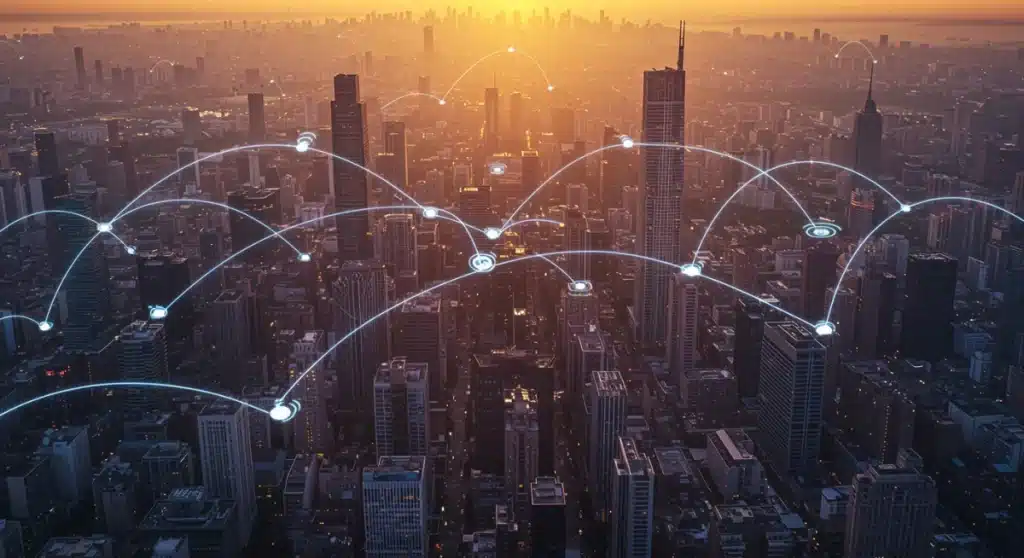5G Advanced 2025: US Consumers & Connectivity Future

The future of connectivity, driven by 5G Advanced and its 2025 rollout, promises transformative implications for US consumers, enhancing speed, reliability, and innovative applications across various sectors.
The Future of Connectivity: 5G Advanced and Its 2025 Rollout Implications for US Consumers is rapidly approaching, poised to redefine how we interact with the digital world. This next evolutionary step in mobile technology promises not just faster speeds but a foundational shift in capabilities, impacting everything from daily routines to critical infrastructure across the United States.
Understanding 5G Advanced: What Sets It Apart
5G Advanced, often referred to as 5.5G, represents a significant upgrade from the initial 5G deployments. It is not merely an incremental bump in speed but a comprehensive enhancement designed to unlock the full potential of next-generation applications and services. This evolution focuses on refining existing 5G technologies while introducing new features that push the boundaries of what cellular networks can achieve.
The core advancements in 5G Advanced revolve around several key areas. These include enhanced mobile broadband (eMBB) with even higher peak data rates and lower latency, critical for immersive experiences like extended reality (XR). It also focuses on massive machine-type communications (mMTC) to support an exponentially larger number of connected devices for the Internet of Things (IoT), and ultra-reliable low-latency communications (URLLC) which is vital for industrial automation, autonomous vehicles, and remote healthcare.
Key Technical Enhancements Driving 5G Advanced
- Enhanced MIMO (Multiple-Input, Multiple-Output): Further optimization of MIMO technology allows for more efficient use of spectrum, increasing capacity and speed, especially in dense urban environments.
- AI/ML Integration: Artificial Intelligence and Machine Learning are being woven into the network’s fabric to optimize resource allocation, predict traffic patterns, and enhance network security and efficiency.
- Smarter Spectrum Utilization: 5G Advanced networks will more intelligently manage diverse spectrum bands, including millimeter-wave (mmWave), mid-band, and low-band, to provide consistent performance across various use cases and geographical areas.
These technical improvements collectively aim to deliver a more robust, intelligent, and flexible network. The goal is to move beyond simply connecting people to enabling a truly interconnected ecosystem where devices, applications, and services communicate seamlessly and intelligently, forming the backbone of future digital economies.
The 2025 Rollout Timeline and Initial Deployments in the US
As 2025 approaches, major US carriers and technology providers are intensifying their efforts to lay the groundwork for 5G Advanced 2025 US deployment. While initial 5G has been widely available, 5G Advanced will see a more targeted and strategic rollout, focusing on critical infrastructure and high-demand areas first. Preliminary deployments are expected to begin in major metropolitan areas, enterprise zones, and key industrial hubs.
Carriers are currently upgrading their existing 5G infrastructure, integrating new hardware and software capabilities that will support the advanced features. This includes deploying more sophisticated antenna systems, enhancing core network virtualization, and preparing for more complex network slicing capabilities. The phased approach allows for rigorous testing and optimization, ensuring that the new functionalities are stable and performant before widespread availability.
Areas of Priority for Early Adoption
- Urban Centers: Dense populations and high data traffic make cities prime candidates for early 5G Advanced deployments, focusing on enhanced mobile broadband.
- Industrial Corridors: Manufacturing plants, logistics hubs, and ports will benefit from URLLC and mMTC for automation and real-time operational control.
- Innovation Zones: Tech parks and research institutions will often be early adopters, leveraging the advanced capabilities for development and testing of new applications.
The rollout in 2025 signifies a critical juncture, moving from theoretical capabilities to tangible, real-world applications. It marks the beginning of a sustained effort to integrate these advanced technologies into the national digital landscape, setting the stage for broader availability in subsequent years. This strategic deployment aims to maximize impact where the demand for advanced connectivity is highest and the potential for economic and social transformation is most significant.
Implications for US Consumers: A New Era of Digital Experience
For US consumers, the rollout of 5G Advanced 2025 US promises a dramatic transformation in their digital lives. Beyond just faster downloads, this next generation of connectivity will enable entirely new experiences and significantly enhance existing ones. The improvements will touch various aspects, from entertainment and communication to personal productivity and access to essential services.
One of the most immediate impacts will be on mobile entertainment. Ultra-high-definition streaming, cloud gaming with virtually no lag, and highly immersive augmented reality (AR) and virtual reality (VR) experiences will become commonplace. Consumers will be able to access rich, interactive content seamlessly, blurring the lines between the digital and physical worlds. The enhanced network capacity means less buffering and more reliable connections, even in crowded areas.
Beyond entertainment, 5G Advanced will also empower more sophisticated smart home ecosystems, enabling a greater number of devices to communicate intelligently and efficiently. Telehealth services will become more robust, allowing for real-time remote diagnostics and consultations with unprecedented clarity. The overall digital experience will be characterized by responsiveness, reliability, and the ability to support a multitude of connected activities simultaneously, redefining consumer expectations for connectivity.

Economic Impact and Job Creation from 5G Advanced
The introduction of 5G Advanced 2025 US is not just a technological leap but a significant economic catalyst for the United States. Industry analysts and economic forecasts predict substantial growth and job creation stemming from the widespread adoption and utilization of this advanced network. The investment in infrastructure, research and development, and the subsequent innovation across various sectors will fuel this economic expansion.
The telecommunications sector itself will see direct job creation in network deployment, maintenance, and the development of new hardware and software. However, the indirect and induced economic effects are expected to be far greater. Industries like manufacturing, healthcare, transportation, and agriculture will leverage 5G Advanced to optimize operations, develop new products and services, and enhance efficiency, leading to new business models and employment opportunities.
Projected Economic Benefits
- Increased Productivity: Enhanced connectivity and automation capabilities will boost productivity across industries, contributing to GDP growth.
- New Market Opportunities: The enablement of innovative services like advanced IoT, smart cities, and immersive digital experiences will create entirely new markets and revenue streams.
- Skilled Labor Demand: A surge in demand for engineers, data scientists, cybersecurity experts, and technicians with specialized 5G Advanced skills is anticipated.
The economic ripple effect will extend to small and medium-sized businesses (SMBs) as well, enabling them to compete more effectively through access to advanced digital tools and broader market reach. This technological advancement is set to solidify the US position as a leader in global innovation, fostering a dynamic economic environment that benefits a wide array of stakeholders.
Challenges and Considerations for Widespread Adoption
While the promise of 5G Advanced 2025 US is immense, its widespread adoption is not without significant challenges and considerations. The path to a fully integrated and ubiquitous 5G Advanced network requires overcoming technical, regulatory, and economic hurdles. Addressing these issues proactively will be crucial for a smooth and effective rollout across the United States.
One primary challenge is the extensive infrastructure investment required. Deploying denser networks, especially for millimeter-wave spectrum, means installing many more small cells and upgrading existing fiber optic backbones. This is a capital-intensive and time-consuming endeavor, requiring significant coordination between carriers, municipalities, and utility providers. Securing rights-of-way and navigating local regulations can also slow down deployment.
Key Hurdles to Overcome
- Spectrum Availability and Allocation: Ensuring sufficient and harmonized spectrum for 5G Advanced services remains a critical regulatory challenge, impacting network capacity and performance.
- Cybersecurity Concerns: As networks become more complex and interconnected, the attack surface expands, necessitating robust cybersecurity measures to protect critical infrastructure and user data.
- Device Compatibility and Cost: Consumers will need compatible devices to fully leverage 5G Advanced capabilities, and the initial cost of these devices could be a barrier for some segments of the population.
Furthermore, educating the public and businesses about the benefits and applications of 5G Advanced is essential to drive demand and ensure adoption. Addressing concerns about data privacy and network security will also be vital in building trust and encouraging broad acceptance of this transformative technology. Overcoming these challenges will require a collaborative effort from government, industry, and consumers.

Security and Privacy in the 5G Advanced Era
With the advent of 5G Advanced 2025 US, the landscape of security and privacy undergoes a significant evolution. The increased network complexity, the proliferation of connected devices, and the reliance on software-defined networking introduce new vectors for potential threats. Protecting user data and ensuring the integrity of critical infrastructure become paramount concerns for carriers, regulators, and consumers alike.
5G Advanced networks are designed with enhanced security features from the ground up, including stronger encryption protocols and more robust authentication mechanisms. However, the sheer volume of data traffic and the expanded attack surface due to IoT devices require a multi-layered approach to cybersecurity. This involves continuous monitoring, threat detection, and rapid response capabilities to mitigate risks effectively. Network slicing, while offering customization, also means that security vulnerabilities in one slice could potentially impact others if not properly isolated.
Privacy concerns are also heightened as more personal and sensitive data traverses these advanced networks. Regulations like the California Consumer Privacy Act (CCPA) and potential federal privacy laws will play a crucial role in governing how data is collected, processed, and shared. Transparency from service providers and robust data protection policies will be essential to maintain consumer trust in the 5G Advanced ecosystem.
Addressing these security and privacy challenges requires ongoing collaboration between government agencies, telecommunications companies, cybersecurity firms, and international partners. Developing industry best practices, investing in advanced security technologies, and fostering a culture of cybersecurity awareness are critical steps to safeguard the future of connectivity. The resilience and trustworthiness of 5G Advanced will be a defining factor in its long-term success and acceptance.
The Future Beyond 2025: Evolution Towards 6G
While the focus is currently on 5G Advanced 2025 US, the telecommunications industry is already looking ahead to the next frontier: 6G. The evolution from 5G Advanced to 6G will represent another fundamental shift in network capabilities, pushing boundaries even further than what 5G Advanced promises. Research and development in 6G are in their nascent stages, but early concepts point towards a vision of hyper-connectivity, intelligent environments, and seamless integration of physical and digital realities.
6G networks are expected to deliver even higher data rates, potentially in the terabit-per-second range, with sub-millisecond latency. This will enable truly holographic communications, advanced tactile internet applications, and the real-time processing of massive datasets at the network edge. The integration of AI will be even deeper, making networks self-organizing, self-optimizing, and highly predictive. New spectrum bands, including sub-terahertz and terahertz frequencies, are being explored to achieve these unprecedented levels of performance.
The vision for 6G extends beyond merely connecting devices to creating an intelligent fabric that supports ubiquitous sensing, advanced robotics, and human-machine interfaces that feel intuitive and natural. It aims to create a truly immersive digital twin of the physical world, enabling real-time interaction and control. This long-term perspective ensures that the innovations brought by 5G Advanced are merely stepping stones towards an even more connected and intelligent future.
The transition from 5G Advanced to 6G will likely involve a continuous evolution, with new features and standards being introduced incrementally. This forward-looking approach ensures that the US remains at the forefront of technological innovation, continually pushing the boundaries of what is possible with wireless communication. The groundwork laid by 5G Advanced will be crucial for informing the architectural and technological choices for 6G, ensuring a smooth and progressive advancement in connectivity.
Key Aspect |
Brief Description |
|---|---|
What is 5G Advanced |
Evolution of 5G with enhanced speed, lower latency, AI integration, and improved capacity. |
2025 US Rollout |
Targeted deployment in major urban centers, industrial hubs, and innovation zones. |
Consumer Impact |
Transformative digital experiences, including ultra-HD streaming, cloud gaming, and advanced smart home integration. |
Key Challenges |
Infrastructure investment, spectrum allocation, cybersecurity, and device compatibility. |
Frequently Asked Questions About 5G Advanced
5G Advanced enhances standard 5G with significantly higher data rates, lower latency, and greater network capacity. It integrates AI/ML for smarter network management, improves MIMO efficiency, and optimizes spectrum utilization, enabling more robust support for XR, IoT, and critical communications.
Initial deployments of 5G Advanced are anticipated to begin in 2025, primarily in major US urban centers, industrial corridors, and innovation zones. Widespread availability will follow a phased approach as infrastructure upgrades continue across the nation.
While current 5G devices may connect to 5G Advanced networks, they might not fully leverage all the new features and performance enhancements. New devices specifically designed for 5G Advanced will be required to experience the full range of benefits and capabilities.
5G Advanced will revolutionize industries such as manufacturing, logistics, and healthcare through enhanced automation, real-time data processing, and advanced IoT applications. It will enable smart factories, autonomous transportation, and sophisticated remote medical services, driving efficiency and innovation.
Key concerns include protecting expanded attack surfaces due to IoT, ensuring robust data encryption, and maintaining network integrity against sophisticated cyber threats. Upholding user privacy through clear regulations and transparent data handling practices will be crucial for building trust and ensuring secure connectivity.
Outlook for US Connectivity
The impending arrival of 5G Advanced 2025 US signals a pivotal moment for connectivity in the United States. This technological leap will lay critical groundwork for emerging digital ecosystems, influencing everything from urban planning to individual digital interactions. Stakeholders across government and industry must continue their collaborative efforts to address infrastructure needs, regulatory frameworks, and cybersecurity challenges, ensuring a robust and equitable transition into this new era of advanced mobile communication.





